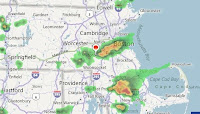Eastern Massachusetts gets about 45 inches of precipitation per year. Roughly ten inches of that falls as snow, the balance as rain. Much of our spring rain comes from vast, drenching weather systems that sweep in from the west or up from the south and give us all-day rain ‘events’ that re-charge our ground water and ensure that May and June are brilliant with color.
 |
| Precipitation in Eastern Massachusetts. Double-click on the chart to see details. |
Then, as the chart at left shows, the rain slows down. By July, we’re dependent on ‘pop-up’ thunderstorms – highly localized downpours caused by unstable air masses. The problem is that these thunderstorms are truly hit or miss. The next town over gets an inch of rain while you get the rumble of distant thunder. Or, the rain may all fall in a few minutes, meaning water runs off rather than soaking into the soil. And, this July, the rains did not come at all to Medfield.
We do not water our lawn and never will. We water newly planted trees, shrubs and perennials for the recommended periods. Because they’re annuals, we water our containers and vegetable garden generously. The primary source of water for our containers is rain barrels – three, 55-gallon drums connected to our downspouts. The secondary source is recycled water from our home. For example, we keep buckets to capture the three gallons of water from our shower while it warms up in the morning. We capture the water used to rinse vegetables. Waterwise, we run a ‘green’ household.
 |
| Pop-up thunderstorms. One town gets drenched, another gets zilch. |
It takes more than 30 gallons of water to drench our 50 containers and, during the hottest days of summer, that needed to be done every other day. Until last week, we were holding our own despite the lack of precipitation. Then, I noticed that one of the shrubs in the large bed in front of our property was in distress. It got the diverted shower water. Other shrubs and perennials quickly began showing the same distress. We hauled water in two- and three-gallon containers to the affected plants and poured it slowly, making certain that every ounce went to the roots and none to waste.
But by Saturday evening we were facing an ethical choice. A week hence, our gardens would be filled with visitors. Our perennials were limp; there was simply no moisture in the soil. There was a 70% chance of rain for Sunday but we agreed that, if we didn’t get substantial rain, we would break out of the hoses and watering wand.
 |
| Sunday morning, 11 a.m. Oh, yeah! |
Sunday morning we awoke to soft rain – the first in more than 30 days. The rain gauge showed that four-tenths of an inch had fallen overnight. An hour later, the rain was steadier and heavier. By noon, the rain gauge showed more than an inch. The weather map showed a conduit of moisture passing steadily over Medfield, fed by Atlantic Ocean moisture. Around 4 p.m., the rain finally stopped; the rain gauge showed a total of 2.4 inches in a twelve-hour period.
This morning, it is as though the month-long dry spell never happened. The perennials in Old Stone Bed are tall and erect. Seedeater’s Heaven, which was prostrate a day earlier, has completely recovered. A quick trowel check of one of the shrub beds shows that there is moisture down at least six inches.
Not every gardener is as serious about water conservation as we are, but then we have to make up for our neighbors who thoughtlessly run their lawn sprinklers despite the watering ban imposed by our town. Ours is not some holier-than-thou attitude toward water in the garden. Rather, it’s learning to live by the same common-sense rules that ought to apply to everyone (and what Betty tells the groups that pay her to speak on the subject). That we have two acres doesn’t give us an exemption. Enough said.

No comments:
Post a Comment